Complementing your Pilates Practice with the GYROTONIC® Method
Blog Content Education Featured Interviews Testimonial Tips for Trainers // February 03, 2023
4 highly-credentialed movement professionals share their experiences
What do you get when you sit down to talk about movement with highly credentialed movement professionals, Dawnna Wayburne, Julie Cordier, Miriam Friedrich-Honorio, and Angela Crowley? Inspired is the first word that comes to mind, but we’re not sure that totally captures the experience, the wisdom, and the energy that radiates from each of them.
Before we dive into the inspiration, a quick introduction to our interviewees:
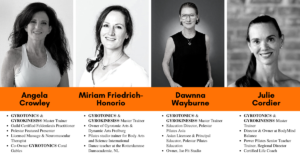
- Julie Cordier is the Director & Owner at BodyMind Balance. She’s a Gyrotonic and Gyrokinesis Master Trainer, Gyrotonic Specialized Master Trainer, and Power Pilates Senior Teacher Trainer, Regional Director. She has studied the Classical Pilates method under Bob Liekens, Jay Grimes, and Kathi Ross-Nash. Julie has taught internationally, and can be found online at Leaders in Fitness.
- Miriam Friedrich-Honorio is the owner of Gyrotonic Arts & Dynamic Arts Frieburg. She’s a Specialized Gyrotonic Master Trainer, Specialized Gyrokinesis Master Trainer, a dance teacher at the Rotterdamnse Dansacademie, and a Pilates studio trainer for Body Arts and Science Int (BASI™). Miriam’s background included 20 years in contemporary dance before transitioning to practicing and teaching Pilates in 2004, and the Gyrotonic Method since 2006.
- Angela Crowley is a Guild Certified Feldenkrais Practitioner®, Licensed Massage & Neuromuscular Therapist, a Gyrotonic and Gyrokinesis Master Trainer and Specialized Gyrotonic Master Trainer. A former gymnast and dancer, Angela was in a car accident which changed her life. As she began the quest to heal herself, she experienced the modalities she now practices. She was certified in the Pilates Method by Romana Kryzanowska in 1989 and served as a keynote speaker for numerous Polestar conferences. Her previous studio, The Phoenix Center for Health Excellence, was an educational site for Polestar and the first studio between the east and west coast to offer the Gyrotonic Method. Today, Angela co-owns GYROTONIC® Coral Gables in Miami, FL where they offer personalized sessions and professional training. Angela also continues to teach and share educational presentations around the world.
- Dawnna Wayburne was trained as a ballet dancer, and has been a registered teacher of the Royal Academy of Dancing and an Associate Diploma holder of the Imperial Society of Dancing for over 30 years. She’s a Gyrotonic and Gyrokinesis Master Trainer who took classes directly from Juliu Horvath in the 1990s at his White Cloud Studio in New York. Dawnna has also trained extensively in the Pilates field and has over the years worked with master teachers of universal repute, some of whom worked with Joseph Pilates himself. Today, Dawnna is the Education Director of Polestar Pilates Asia, the Asian Licensee, a Principal Educator for Polestar Pilates Education, and owner of Iso Fit Studio Hong Kong.
Building Your Tapestry of Movement
Although their backgrounds and paths that led them to the Gyrotonic & Gyrokinesis Methods may differ, each can pinpoint the exact moment they knew this modality was for them.
Dawnna Wayburne and Angela Crowley came to the Gyrotonic & Gyrokinesis Methods through injury. For Dawnna, a broken tailbone and Angela, a debilitating car accident.
“You meet the right people at the right time, and learning the Feldenkrais method I understood then, that you take these alternative methods to create a tapestry. I always see my teaching as a tapestry, you take the colors but you don’t dilute them. It’s so easy to use a Gyrotonic hand cue in Pilates, or to teach a Feldenkrais move and not attribute it, but once you attribute it and give it its place, then your tapestry just shines because each color pops as opposed to being muddy watercolor and brown. I think that was my fortune in starting out as a dancer and the explorative mind behind it. We so often come across where people want to draw from modalities and call it their own rather than acknowledging they stand on the shoulders of all these great people and that they drew these threads out to create that which they are,” Dawnna said.
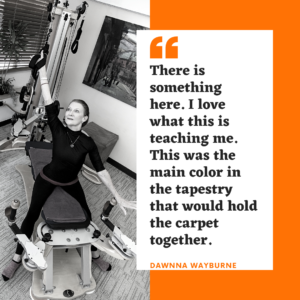
Dawnna Wayburne finds the main color in her tapestry of movement with The Gyrotonic and Gyrokinesis Methods
For her, the Gyrotonic and Gyrokinesis Methods came at a time when Dawnna didn’t know how much she needed them. “I fell across the Gyrotonic Method through Geta Constantinescu, at the Academy of Performing Arts, she was an inspiration all on her own. I kept looking at this piece of equipment in the corner (Pulley Tower) and Geta said, ‘you really have to learn.’ Not long after, Dawnna fell backwards from a ladder and experienced a broken tailbone. “It was mostly fine, but every couple of weeks everything seized up. Not long after, I went to train in San Francisco with Polestar Founder Brent Anderson for some of the Pilates work he was doing there. They had a Jumping-Stretching Board at the Ballet and from the moment I tried it, I thought, ‘there is something here, I love what this is teaching me.’ This was the main color in the tapestry that would hold the carpet together.”
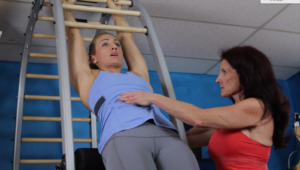
Angela Crowley works with two-time National Champion Canadian diver, Melanie Rinaldi, training on the Gyrotonic Archway
In Angela’s case, after the car accident that changed her life, traditional medicine approaches such as traction in the hospital and intensive physical therapy had only helped a little. She didn’t accept this outcome, began searching, and met a naturopathic doctor who directed her towards a holistic path consisting of Pilates, deep neuromuscular therapy, osteopathy, acupuncture, and anti-inflammatory dietary changes. Around this time she also began studying The Feldenkrais Method®, which utilizes developmental and evolutionary organic movement patterns. At the time, she was struggling to apply these approaches to the systematic movement in Pilates. Not long after came the ‘Golden Moment’ as Angela refers to it. “I saw a picture of someone on a Gyrotonic machine with her hands on the handles. I could see that the movement of the handles gave access to, and facilitated, the movement of the spine, ribcage, and torso. My search was answered. I went to New York and studied with Juliu Horvath, who was still making each of the Gyrotonic machines by hand, at that time. “My first experience with Juliu blew my mind. I had never experienced anything like that – he knows how to move internal energy through breath and movement in a way that completely shifted my entire self. I’ve now been teaching the Gyrotonic Method for more than 25 years and remain equally passionate today about the endless possibilities of the system.”
For Julie, it was at the BodyMind Spirit conference in California many years ago where she had the chance to observe and try exercises on the equipment. She had never experienced anything like it and was completely mesmerized. She was in the midst of Comprehensive Pilates Training with Power Pilates and knew once that training was complete, her next focus would be the Gyrotonic Teacher Training program. In 2004, Julie began teaching Pilates, and in 2007, her studio BodyMind Balance became the first to offer Gyrotonic exercise in Cincinnati, Ohio.
Miriam Friedrich-Honorio says she fell in love from the first moment. After spending 20 years in contemporary dance, when she found herself no longer dancing, she longed for something that could replace the joy and satisfaction and way of expressing and communicating what she had felt previously with dancing. Gyrotonic simply felt so right, so organic, and true that she knew she wanted to become a Gyrotonic & Gyrokinesis Trainer.
“It is a healing system for me that as such, I had to discover. In the beginning, it did replace dance. I’m not a good talker, you have to know. The methods helped me to better communicate with myself and with the outside world. I feel these methods are the way to get the closest to myself with honesty, love, and care.”
ON COMPLEMENTING A PILATES PRACTICE
These movement professionals have found that the Gyrotonic and Gyrokinesis methods are a great complement to a Pilates practice, and that each modality supports the other.
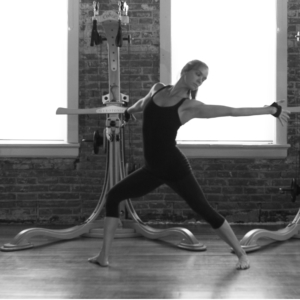
Julie Cordier creates space in her body with the GYROTONIC® Cobra® Pulley Tower Unit.
“For me, Classical Pilates is very organized, grounded and stable,” says Julie Cordier. “I move deeply through those connections in every range of motion (therefore my Classical Pilates workout is very varied on equipment and in exercises within the method) and for me, it helps to maintain an even alignment in my spine and hips, as I have a mild scoliosis. Pilates helps me easily take care of myself and is very efficient and straightforward. The Gyrotonic and Gyrokinesis Methods allow me to explore movement in a limitless way and channel energy through my body with and without the equipment. I am able to clearly follow my patterns of alignment in spirals, figure 8’s, etc. when I have a stable and aligned base from Pilates. For me, they work together. I only teach the Gyrotonic Method and Classical Pilates method. In general, my teaching is very clear, paced and balanced in technique and flow. I workshop various elements of technique and thread them into the session with teaching themes through the week with my clients. Their workouts are a nice balance of physical and mental growth as they gain skills in movement and understand that it greatly enhances their daily lives.”
Miriam says, “my Pilates practice is more gentle, finding the strength – not only muscular strength, but the collaboration of different systems. I grew up with the Pilates Method according to Body Arts and Science (BASI™), quite contemporary and yet classical, but with lots of scientific research-based changes and modifications. Yet, the complex three-dimensional approach of the Gyrotonic Method, its principles inspired my Pilates approach.
Dawnna believes the Gyrotonic equipment does so much in a very organic way. “It shines a different light on the biomechanics and organic qualities of those shapes that are also present in the Pilates system.” She adds, “Primal movement, spiral, everything that comes within this cosmic glow that we inhabit. It brings together the earthiness of Pilates.”
For Angela, it’s all about the experience that happens throughout the entire body. “It’s the experience that makes you want more. I don’t compare the Gyrotonic Method and Pilates – you can’t make applesauce out of oranges – they’re completely different from the inside out. The Gyrotonic and Gyrokinesis Methods move from the inside out. The essence is the internal energy and breath moving through the spine and out to the extremities while nourishing our vital organs and health systems,” Angela says. She adds “Many people including myself have neck and low-back problems. In order to solve those issues, you have to deal with the movement between the two – the mid-back and ribcage. The Gyrotonic Method enables one to distribute the articulation of movement throughout the torso beautifully. This reduces the stress on the neck and low back. Gyrotonic and Gyrokinesis are so different from anything else out there, you cannot know until you’ve felt it.”
HOW THE GYROTONIC METHOD HAS HELPED THEIR CLIENTS
Practicing the Gyrotonic and Gyrokinesis Methods has resulted in life-changing impact for each of these women, but perhaps the only thing better than experiencing it yourself is being able to help others experience it. We talked with these women about the benefits they’ve noticed with their clients.
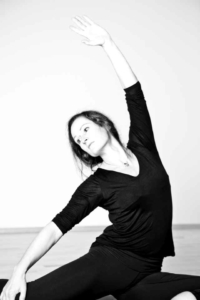
Miriam Friedrich-Honorio appreciates the three-dimensional approach of the Gyrotonic and Gyrokinesis Methods.
For Miriam, nothing warms her heart more than seeing the impact this work has on her clients. “That inner strength, emotional and mental healing and strength, in addition to the physical, is amazing. I’ve seen clients gain uprightness, gain breath capacity and an increase in happiness. They’ve gained mobility, the feeling of youth, agility, and inner and outer strength. I’ve seen many fantastic benefits for those in physical rehabilitation programs, too.”
Julie has seen numerous positive impacts: “For many clients, I see a huge amount of ownership of how they take care of their bodies. Injuries or movement patterns that have bothered them for years are not an issue anymore, and their muscular development has changed greatly. Their internal systems – digestion, respiration, circulation – function in a healthier way and this brings a new level of ease and peace into their lives. The stress-relief component is a huge benefit these days, too.”
Dawnna has seen amazing results with her functional re-education clients, where she spends a considerable amount of her time. For those with Parkinson’s, she’s seen how the Gyrotonic and Gyrokinesis Methods help with gait and timing. “The rhythmic nature of the Gyrotonic Method is such that when they finish the exercises and begin to walk again, the gait pattern is that much improved.”
Dawnna continues, “I often say in training, if you look at people at the Wailing Wall/Western Wall or the orphans in Bosnia years ago – the rocking action is to seek balance, to find the midline, but they don’t have it so they have to rock. We can engineer it to find the balance point, and for a Parkinson’s client, that can be really important. It’s the same for young children with ADHD or an autism diagnosis. Once I was sitting with a highly autistic boy who was fixated on rocking, so I sat next to him and rocked with him. Then I changed the timing of my rocking, slowing it way down. After a few minutes his slowed down. And then I suddenly changed the rocking to look up at the fan and down at my feet. It took a while, but we managed to get from simple rocking to a little bit of arch and curl and started a spiral. These are just two examples of how the systems of the Gyrotonic and Gyrokinesis Methods are geared towards improving the quality of lives moving forward.”
WORDS OF WISDOM
Are you considering the Gyrotonic Teacher Training Program? If you’re looking for a way to differentiate your movement practice or studio offerings, or you’re looking to experience a truly three dimensional, organic movement method, do you know where to start? Go take a class. Experience the work. Listen to how your body feels. “Be a student for a while before you put yourself into the teacher position. You need the experiences and your own process,” adds Miriam.
Angela has seen both first hand and among peers many successes and she offers this advice: “If you are a Pilates teacher or student, you appreciate intelligent movement. I believe you will love expanding into the flowing functional movement patterns and diverse Gyrotonic equipment. The Gyrotonic Method approach opens new horizons, expands your practice and reaches new audiences while providing a competitive edge and advantage.”
“For me, it is a unique career that I never would have imagined. It is an investment in yourself that will pay dividends personally, professionally, financially, and will give you the skills to live in your body in a profound way. You are able to share this with your community and greatly be of service and build relationships with people,” says Julie.
Dawnna says, “Practicalize the work first. Spend a lot of time, pay a lot of attention to the words in the manual. Read the words from Juliu, they are so meaningful and well laid out. If you follow all the steps as they were laid out, it’s like the yellow brick road.” She adds, “Take your time with progression one. It’s so powerful. Juliu’s work is so powerful in its simplicity. His basic work really completes all of it. You just need the basis of his work and you will be the trainer you want to be in this modality. And you will arrive. But you don’t want to fly over that.”
WHERE TO FIND A CLASS
There are over 10,000 Gyrotonic & Gyrokinesis Trainers across the globe. You can find a studio near you at https://www.gyrotonic.com/studios/.
Interested in Teacher Training? We’ve got all the information you need here: https://www.gyrotonic.com/teacher-training/
GET CECs
Did you know you can receive Continuing Education Credits for all the Gyrotonic and Gyrokinesis Level 1 Courses and Specialized Equipment Courses if you are a PMA member with a NPCP certification? The PMA is now granting their certificants’ CECs for attending the Gyrotonic and Gyrokinesis courses listed below. That means, when NPCP certified students attend one of these courses, they will be able to fulfill their NPCP CEC requirements. The NPCP info will be printed on the bottom of the certificates and students will present the certificate to the PMA to receive their CECs. See the image below for qualifying courses.
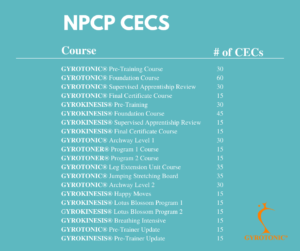
Feldenkrais®, Feldenkrais Method®, Functional Integration®, and Awareness Through Movement® are Service Marks of The Feldenkrais Guild® of North America.
